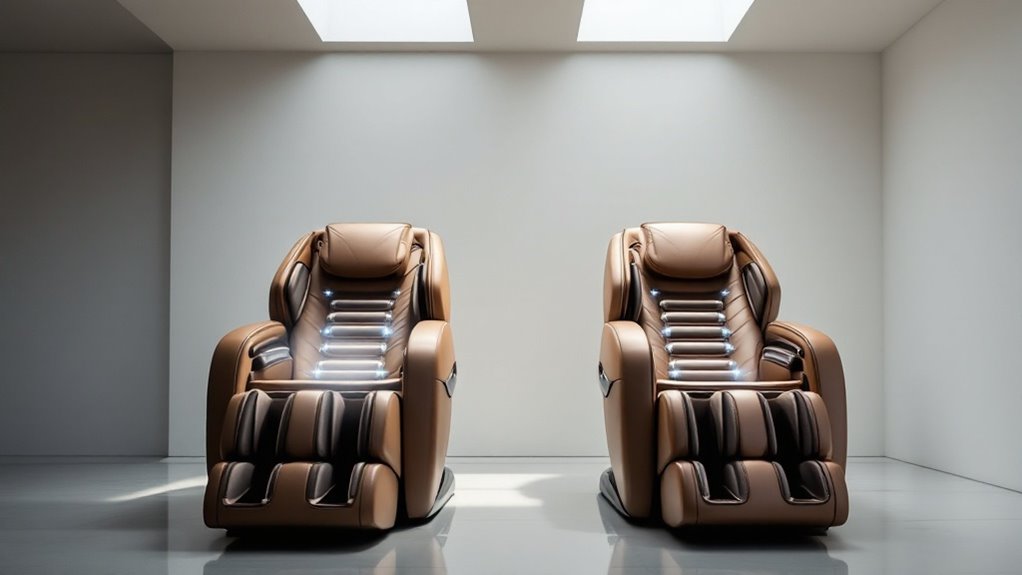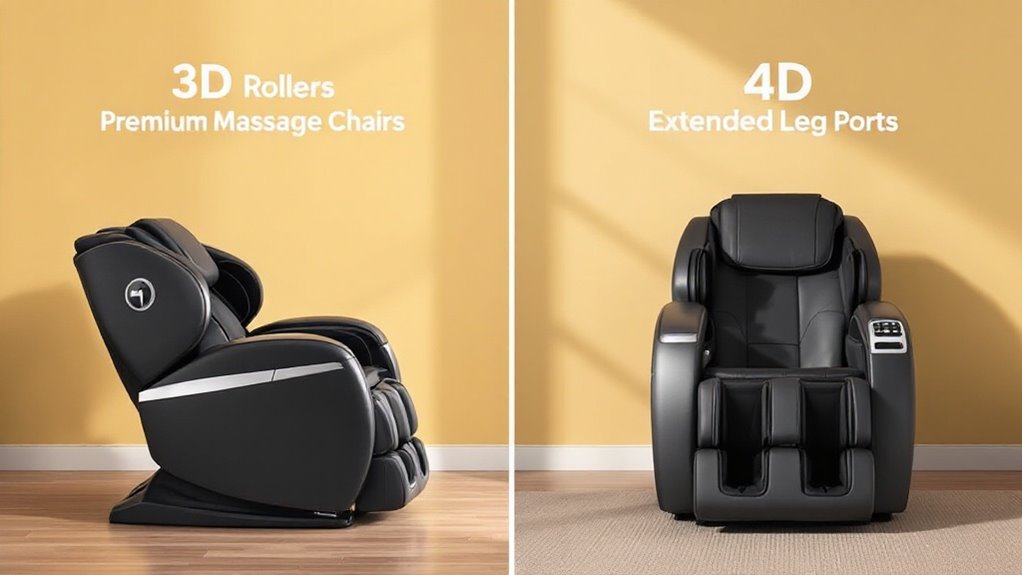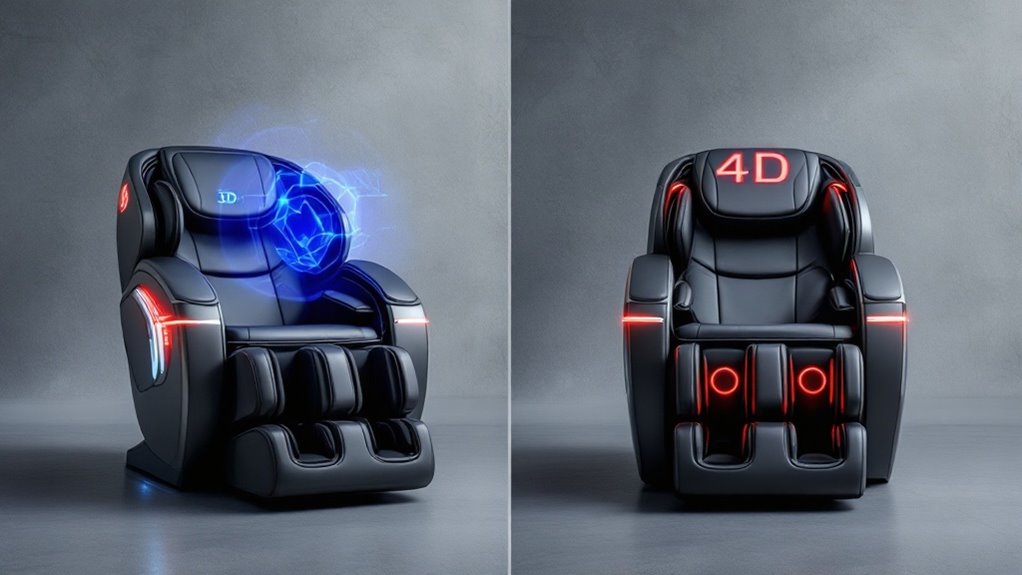The choice between 3D and 4D massage chairs depends on personal needs and budget. 3D chairs provide basic movement in three directions, while 4D models add speed variation for a more dynamic experience. 4D chairs offer premium features and closer simulation of human massage techniques, but come at a higher price point. Space requirements, user comfort, and technical preferences should factor into the decision. Understanding the key differences helps determine which type will deliver ideal value and satisfaction.
Key Takeaways
- 4D chairs offer more sophisticated massage experiences with variable speeds and rhythms, while 3D chairs provide basic up/down, left/right, and depth movements.
- Budget-conscious buyers may prefer 3D chairs, as 4D models typically cost more due to their advanced technology features.
- 4D massage chairs better mimic human massage techniques through rhythmic speed variations, making them ideal for therapeutic needs.
- Users seeking basic massage functionality and simpler controls might find 3D chairs more suitable and easier to operate.
- Consider space requirements and technical comfort level, as 4D chairs often require more room and feature more complex controls.
Understanding the Key Differences Between 3D and 4D Massage Chairs

While both 3D and 4D massage chairs offer advanced therapeutic capabilities, their fundamental difference lies in how their rollers move and operate.
3D massage chairs feature rollers that move in three dimensions: up/down, left/right, and in/out (depth). This allows them to follow the spine’s natural curvature and adjust pressure intensity.
4D massage chairs incorporate all the movements of 3D chairs plus a fourth dimension: rhythm or speed variation.
This additional capability enables the rollers to alternate between fast and slow movements, creating a more dynamic massage experience. The varying speeds help simulate the rhythmic techniques used by massage therapists, making 4D chairs closer to replicating the feeling of human hands during treatment.
This speed control also allows for more specialized massage programs and techniques.
Making the Right Choice: Factors to Consider When Selecting Between 3D and 4D Models

When choosing between 3D and 4D massage chairs, consumers must evaluate several critical factors to make an informed decision.
Budget considerations play a primary role, as 4D models typically command higher prices due to their advanced technology. Users should assess their specific massage needs, including the intensity and variety of techniques required. Those seeking basic massage functionality may find 3D chairs sufficient, while individuals wanting premium features and customization options might prefer 4D models.
Physical space limitations and room aesthetics should also factor into the decision, as these chairs can occupy significant floor space. Additionally, users should consider their technical comfort level, as 4D chairs often feature more complex controls and settings.
Warranty coverage, after-sales support, and the manufacturer’s reputation are equally important elements to evaluate before making the final selection.
FAQ
How Long Do 3D and 4D Massage Chairs Typically Last?
Quality 3D and 4D massage chairs typically last between 5 to 10 years with proper maintenance and regular use.
Higher-end models can function well for up to 15 years.
The lifespan largely depends on factors such as usage frequency, maintenance schedule, build quality, and environmental conditions.
Most manufacturers offer warranties ranging from 3 to 5 years, indicating their expected durability.
Can Pregnant Women Safely Use 3D or 4D Massage Chairs?
Pregnant women should exercise caution with massage chairs.
While some manufacturers state their chairs are safe during pregnancy, medical professionals generally advise against using massage chairs, especially during the first trimester.
The intense vibrations, pressure points, and heating functions could potentially affect the developing fetus.
Women should always consult their healthcare provider before using any massage chair during pregnancy.
Are Massage Chairs Covered by Health Insurance or Fsa/Hsa Accounts?
Coverage for massage chairs through health insurance is rare, as most insurers consider them personal comfort items rather than medical necessities.
However, FSA and HSA accounts may cover massage chairs if prescribed by a healthcare provider for a specific medical condition.
Documentation from a physician stating the medical necessity is typically required for FSA/HSA reimbursement eligibility.
What’s the Average Power Consumption of 3D Versus 4D Massage Chairs?
While many assume massage chairs are energy-efficient relaxation tools, they actually consume significant power.
3D massage chairs typically use 100-150 watts during operation, similar to a medium-sized TV.
4D models, with their additional movements and features, consume 150-200 watts on average.
During standby mode, both types draw about 1-2 watts, making their yearly energy impact surprisingly substantial.
Can Children Safely Use 3D or 4D Massage Chairs?
Children should not use massage chairs without adult supervision, as these devices are designed for adult bodies.
Most manufacturers recommend users be at least 12-14 years old. Younger children face risks from the powerful mechanical components and intense pressure settings.
If allowing supervised use for older children, sessions should be brief, using gentle settings, and avoiding areas near the spine and neck.
Conclusion
When choosing between 3D and 4D massage chairs, consider your wellness goals, space, and budget. While both options offer therapeutic benefits, they differ in functionality and features. 3D chairs provide effective relief through rollers that move up/down, left/right, and in/out, delivering targeted pressure to specific areas. 4D chairs enhance this experience by adding speed variation to the massage movements, creating a more dynamic and customizable massage that closely mimics human touch.
4D technology offers superior intensity control and rhythm adjustments, making it ideal for users seeking a premium massage experience. The variable speed control allows for gentler strokes in sensitive areas and deeper pressure where needed. However, this advanced technology comes at a higher price point.
3D chairs, while more affordable, still deliver excellent therapeutic benefits and are suitable for most users. They effectively target muscle tension and provide reliable relaxation, though with less customization than their 4D counterparts.
Your choice should align with your specific needs, whether you prioritize advanced features and customization (4D) or seek effective relief at a more moderate investment (3D).







